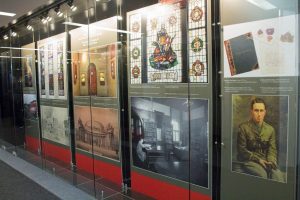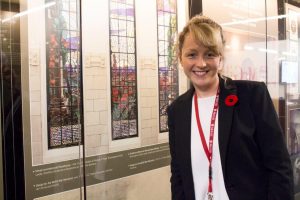
ROAAr logo designed by Greg Houston
La version française suit
Introduction
In September 2016, the McGill Library brought its four rare collection units—Rare Books & Special Collections, the Osler Library of the History of Medicine, the Visual Art Collection, and Archives & Record Management—together under one umbrella. Together, the unified “ROAAr” group helps showcase the unique holdings within each of the four branches through cross-unit collaboration, strengthening and distinguishing their rich collections and the Library as a whole.
The logo, designed by Digital Library Services’ Greg Houston, mirrors the tenacity of ROAAr’s mission; it is a Venetian lion, inspired by a limestone carving that sits atop the old Redpath Library Building, perched on a book, symbolizing power, wisdom and justice.
ROAAr has already begun bringing together students, faculty and researchers from across McGill and beyond, hosting public lectures on artists Edward Lear and Paul Kane, a presentation on the Blacker-Wood collection in Zoology and Ornithology and a visit from the Grolier Club, the oldest existing bibliophilic club in North America.
ROAAr comes together to Remember
By Hayley Eaves, B.A. 2016, M.A. 2018 (expected)
Nearly one hundred years after the end of the First World War, institutions across Canada are looking back and remembering our country’s important role in the conflict and its resolution. McGill played its own role, with many of the University’s men and women serving during the Great War.

A detail of the display, “Through Tragedy We Transform: The Metamorphosis of the McGill University Campus in the Aftermath of the Great War (1914-1918),” on view in the James Building Lobby. Photo credit: Lauren Goldman
As a community, McGill has done its part to remember its own commitment to Canada’s effort. In the McGill Library, the various units within ROAAr in particular have collaborated using their unique materials to honour the lives and sacrifices paid on battlefields abroad. The Osler Library of the History of Medicine, for example, mounted an exhibition on the McGill’s No. 3 Canadian General Hospital in France, displaying its own rare documents and memorabilia, while the McGill University Archives created a facsimile of the Book of Remembrance, an exquisitely hand-lettered, illuminated record of every McGillian who lost their lives in the two World Wars. The facsimile is on view in the McLennan Library lobby, while the original, recently restored, is available for viewing in the Rare Books & Special Collections and Archives Reading Room. A digitized version can be viewed on the McGill Remembers website.
This fall, the Visual Arts Collection decided to investigate how the First World War transformed McGill’s physical spaces on both campuses. How did changing spaces reflect broader shifts precipitated by the War and themselves reshape the campus community? As an Arts Undergraduate Society summer intern, I was assigned the project. With a plan to mount a display in the James Building lobby, I became immersed in nothing short of detective’s work, scouring the ROAAr collections for any and all material related to the University’s transformation after the First World War. Finding an extraordinary array of drawings, architectural plans, photographs, archival documents and other materials, I faced a common curatorial question: how could we make this complex story simple enough for display?
The result, “Through Tragedy We Transform: The Metamorphosis of the McGill University Campus in the Aftermath of the Great War (1914-1918),” is now on view in the James Building. Reproductions of the artworks and monuments that followed from the Great War are on display in large, colourful panels. Seen together, they inspire us to honour past McGillians who sacrificed their lives to the war effort–an effort that very much remains marked in the history of the University. The approach of the Visual Arts Collection was, as always, to say less in words and show more in images.
What do the images remember for us? After the War, stunning libraries for Art, Architecture and Chemistry came to life, exquisite stained glass windows were added to existing buildings, a stadium was enhanced, and an elaborate Memorial Convocation Hall was planned.
The First World War was, for many, an end. At McGill, remembrance of the tragedy via gifts sparked creativity and growth. Through tragedy, we transformed.
With thanks to Wes Cross, Dan Doran, Peter Hoffmann, Kinny Kreiswirth, Gwendolyn Owens and Thomas Thompson. This project was made possible by support from McGill Associates, Friends of McGill and McGill Remembers.
Introduction
En septembre 2016, la bibliothèque McGill a fusionné quatre groupes de collections rares : Livres rares et collections spécialisées, la bibliothèque Osler (histoire de la médecine), la Collection d’arts visuels et les Services des archives de l’Université McGill. Ce regroupement, le « ROAAr », met en valeur les collections uniques de chacun de ses quatre groupes qui collaborent entre eux, ce qui leur permet de promouvoir leurs riches collections et la bibliothèque dans son ensemble tout en conservant leur caractère distinctif.
Conçu par Greg Houston, des services numériques de la bibliothèque, son logo évoque la ténacité et la mission du ROAAr; un lion vénitien, inspiré d’une pièce sculptée dans la pierre calcaire qui se trouve au sommet du vieux bâtiment de la bibliothèque Redpath, repose sur un livre, qui symbolise le pouvoir, la sagesse et la justice.
Le ROAAr a déjà commencé à réunir étudiants, professeurs et chercheurs de McGill et d’ailleurs, en organisant des conférences publiques sur les artistes Edward Lear et Paul Kane, une présentation sur la collection Blacker-Wood du domaine de la zoologie et de l’ornithologie et une visite des membres du Club Grolier, le club de bibliophiles le plus ancien en Amérique du Nord.
Le ROAAr, tous ensemble pour se souvenir
Par Hayley Eaves, B.A. 2016, M.A. 2018 (prévu)
Près de cent ans après la fin de la Première Guerre mondiale, les établissements de partout au Canada prennent du recul et se souviennent du rôle important qu’a joué notre pays dans ce conflit et de sa résolution. McGill y a joué son propre rôle, car de nombreux mcgillois, hommes et femmes, ont pris part à la Grande Guerre.

Un aperçu de la présentation « Une tragédie qui nous a transformés: La métamorphose du campus de l’université McGill au lendemain de la Grande Guerre (1914-1918) » accessible dans le hall de l’édifice James. Photo Lauren Goldman
En tant que collectivité, McGill a pris les mesures nécessaires pour se souvenir de son propre engagement envers les efforts de guerre du Canada. Dans la bibliothèque de McGill, les groupes qui composent le ROAAr ont tout particulièrement collaboré en utilisant leurs propres documents pour honorer la vie et les sacrifices des militaires morts sur les champs de bataille à l’étranger. La bibliothèque Osler (histoire de la médecine), par exemple, a préparé une exposition sur l’hôpital général canadien n° 3 mis sur pied par McGill en France en présentant ses propres documents rares et souvenirs, tandis que les Services des archives de l’Université McGill ont créé un facsimilé du Livre du souvenir, un document illustré d’une grande qualité, écrit à la main, portant sur tous les mcgillois morts pendant les deux guerres mondiales. Le facsimilé est présenté dans le hall de la bibliothèque McLennan, tandis que l’original, restauré récemment, peut être examiné dans la salle de lecture des Livres rares et collections spécialisées et des services des archives. Une version numérisée peut être consultée sur le site web McGill se souvient.
Cet automne, les responsables de la Collection d’arts visuels ont décidé d’examiner comment la Première Guerre mondiale a transformé les lieux physiques des deux campus de McGill. Comment la transformation des lieux a-t-elle reflété les changements généraux provoqués par la guerre et comment ces lieux ont-ils remodelé la collectivité des campus? En tant que stagiaire d’été de l’Association étudiante de la Faculté des Arts de Premier Cycle, j’ai été affectée au projet. Le plan consistait à présenter l’exposition dans le hall de l’édifice James. J’ai été absorbée dans ma tâche qui n’était rien de moins qu’un travail de détective, alors que je fouillais les collections du ROAAr à la recherche de tous les documents liés à la transformation de l’Université après la Première Guerre mondiale. En constatant l’extraordinaire quantité de dessins, plans architecturaux, photographies, documents d’archives et autres documents que je découvrais, je me suis posé une question qui est commune dans le domaine de la conservation : comment cette histoire complexe peut-elle être simplifiée suffisamment pour être présentée?
Le résultat de ce travail, une présentation intitulée « Une tragédie qui nous a transformés: La métamorphose du campus de l’université McGill au lendemain de la Grande Guerre (1914-1918) », est désormais accessible dans l’édifice James. Des reproductions des oeuvres d’art et des monuments qui ont suivi la Grande Guerre sont exposés sur de grands panneaux colorés. Vus ensemble, ces documents nous amènent à honorer les anciens mcgillois qui ont sacrifié leur vie en participant à l’effort de guerre, un effort qui a laissé une marque indélébile dans l’histoire de l’Université. L’approche adoptée par les responsables de la Collection d’arts visuels a été, comme toujours, de préférer les images aux mots.
Que nous rappellent les images? Après la guerre, des bibliothèques extraordinaires dans le domaine des arts, de l’architecture et de la chimie ont vu le jour, des vitraux remarquables ont été installés dans les édifices existants, un stade a été amélioré et on a prévu l’aménagement d’une salle de réunion commémorative détaillée.
Pour plusieurs, la Première Guerre mondiale a marqué une fin. À McGill, le souvenir de cette tragédie par l’entremise d’oeuvres laissées en héritage a favorisé la créativité et la croissance. Par la tragédie, nous nous sommes transformés.
Avec la précieuse collaboration de Wes Cross, Dan Doran, Peter Hoffmann, Kinny Kreiswirth, Gwendolyn Owens et Thomas Thompson. Ce projet a été rendu possible grâce au soutien des partenaires et amis de McGill et du regroupement McGill se souvient.















Leave a Reply
You must be logged in to post a comment.